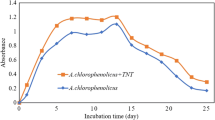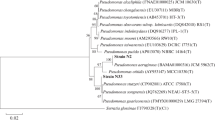Abstract
2,4,6-trinitrotoluene (TNT), a nitro-aromatic explosive commonly used for defense and several non-violent applications is contributing to serious environmental pollution problems including human health. The current study investigated the remediation potential of a native soil isolate, i.e., Indiicoccus explosivorum (strain S5-TSA-19) isolated from collected samples of an explosive manufacturing site, against TNT. The survivability of I. explosivorum against explosives is indirectly justified through its isolation; thus, it is being chosen for further study. At a TNT concentration of 120 mg/L within an optimized environment (i.e., at 30 °C and 120 rpm), the isolate was continually incubated for 30 days in a minimal salt medium (MSM). The proliferation of the isolate and the concentration of TNT, nitrate, nitrite, and ammonium ion were evaluated at a particular time during the experiment. Within 168 h (i.e., 7 days) of incubation, I. explosivorum co-metabolically degraded 100% TNT. The biodegradation procedure succeeded the first-order kinetics mechanism. Formations of additional metabolites like 2,4-dinitrotoluene (DNT), 2,4-diamino-6-nitrotoluene (2-DANT), and 2-amino-4,6-dinitrotoluene (2-ADNT), were also witnessed. TNT seems to be non-toxic for the isolate, as it reproduced admirably in TNT presence. To date, it is the first report of Indiicoccus explosivorum, efficiently bio-remediating TNT, i.e., a nitro-aromatic compound via different degradation pathways, leading to the production of simpler as well as less harmful end products. Further, at the field-scale application, Indiicoccus explosivorum may be explored for the bioremediation of TNT (i.e., a nitro-aromatic compound)-contaminated effluents.
Graphical abstract






Similar content being viewed by others
Data availability
The datasets generated and/or analyzed during the current study are not publicly available as they also form part of an ongoing study but are available from the corresponding author on reasonable request.
References
Van Aken B, Agathos SN (2001) Biodegradation of nitro-substituted explosives by white-rot fungi: a mechanistic approach. In: Laskin AI, Bennett JW, Gadd G (eds) Advances in applied microbiology. San Diego Academic Press, San Diego, pp 1–77. https://doi.org/10.1016/s0065-2164(01)48000-2
Alothman ZA, Bahkali AH, Elgorban AM, Al-Otaibi MS, Ghfar AA, Gabr SA, Wabaidur MS, Habila AM, Ahmed AYBH (2020) Bioremediation of Explosive TNT by Trichoderma viride. Molecules 25(6):1393. https://doi.org/10.3390/molecules25061393
Ayoub K, Hullebusch VDE, Cassir M, Bermond A (2010) Application of advanced oxidation processes for TNT removal: a review. J Hazard Mater 178(1–3):10–28. https://doi.org/10.1016/j.jhazmat.2010.02.042
Boopathy R, Wilson M, Kulpa CF (1993) Anaerobic Removal of 2,4,6-Trinitrotoluene (TNT) under Different Electron Accepting Conditions: Laboratory Study. Water Environment Research 65(3): 271–275. http://www.jstor.org/stable/25044298
Chatterjee S, Deb U, Datta S, Walther C, Gupta DK (2017) Common explosives (TNT, RDX, HMX) and their fate in the environment: emphasizing bioremediation. Chemosphere 184:438–451. https://doi.org/10.1016/j.chemosphere.2017.06.008
Chien CC, Kao MC, Chen YD, Chen CS, Chen CC (2014) Biotransformation of trinitrotoluene (TNT) by Pseudomonas spp isolated from a TNT-contaminated environment. Environ Toxicol Chem 33(5):1059–1063. https://doi.org/10.1002/etc.2553
Claus H, Bausinger T, Lehmler I, Perret N, Fels G, Dehner U, Preuß J, König H (2007) Transformation of 2,4,6-trinitrotoluene (TNT) by Raoultella. Biodegradation 18(1):27–35. https://doi.org/10.1007/s10532-005-9033-7
Conder JM, Point TW, Bowen AT (2004) Preliminary kinetics and metabolism of 2,4,6-trinitrotoluene and its reduced metabolites in an aquatic oligochaete. Aquat Toxicol 69(3):199–213. https://doi.org/10.1016/j.aqua-tox.2004.04.013
Cook AM, Huetter R (1981) s-Triazines as nitrogen sources for bacteria. J Agric Food Chem 29(6):1135–1143. https://doi.org/10.1021/jf00108a009
Dalton H, Stirling DI, Quayle RJ (1982) Co-metabolism philosophical transactions of the royal society B. Biol Sci 297(1088):481–496. https://doi.org/10.1098/rstb.1982.0056
Duque E, Haidour A, Godoy F, Ramos LJ (1993) Construction of a pseudomonas hybrid strain that mineralizes 2,4,6-trinitrotoluene. J Bacteriol 175(8):2278–2283. https://doi.org/10.1128/jb.175.8.2278-2283.1993
Esteve-Nunez A, Caballero A, Ramos JL (2001) Biological degradation of 2,4,6-Trinitrotoluene. Microbiol Mol Biol Rev 65(3):335–352. https://doi.org/10.1128/mmbr.65.3.335-352.2001
Fahrenfeld N, Zoeckler J, Widdowson AM, Pruden A (2013) Effect of bio stimulants on 2,4,6-trinitrotoluene (TNT) degradation and bacterial community composition in contaminated aquifer sediment enrichments. Biodegradation 24:179–190. https://doi.org/10.1007/s10532-012-9569-2
Gümüscü B, Tekinay T (2013) Effective biodegradation of 2,4,6-trinitrotoluene using a novel bacterial strain isolated from TNT-contaminated soil. Int Biodeterior Biodegrad 85:35–41. https://doi.org/10.1016/j.ibiod.2013.06.007
Gün Gök Z, İnal M, Yiğitoğlu M (2019) Biodegradation of 2,4,6-trinitrotoluene (TNT) with bacteria isolated from TNT-polluted waste pink water. Periodica Polytechnica Chem Eng 63(3):459–468. https://doi.org/10.3311/ppch.13390
HaÏdour A, Ramos JL (1996) Identification of products resulting from the biological reduction of 2,4,6-Trinitrotoluene, 2,4-Dinitrotoluene, and 2,6-Dinitrotoluene by Pseudomonas spp. Environ Sci Technol 30(7):2365–2370. https://doi.org/10.1021/es950824u
Heiss G, Knackmuss HJ (2002) Bioelimination of trinitroaromatic compounds: immobilization versus mineralization. Curr Opin Microbiol 5:282–287. https://doi.org/10.1016/S1369-5274(02)00316-8
Juhasz LA, Naidu R (2007) Explosives: Fate, dynamics, and ecological impact in terrestrial and marine environments. Rev Environ Contam Toxicol 191:163–215. https://doi.org/10.1007/978-0-387-69163-3_6
Kalafut T, Wales ME, Rastogi VK, Naumov PR, Zaripova KS, Wild RJ (1998) Biotransformation patterns of 2,4,6-Trinitrotoluene by aerobic bacteria. Curr Microbiol 36:45–54. https://doi.org/10.1007/s002849900278
Kalderis D, Juhasz LA, Boopathy R, Comfort S (2011) Soils contaminated with explosives: environmental fate and evaluation of state-of-the-art remediation processes (IUPAC technical report). Pure Appl Chem 83(7):1407–1484. https://doi.org/10.1351/PAC-REP-10-01-05
Kao MC, Lin HB, Chen CS, Wei FS, Chen CC, Yao LC, Chien CC (2016) Biodegradation of trinitrotoluene (TNT) by indigenous microorganisms from TNT-contaminated soil, and their application in TNT bioremediation. Bioremediation J 20(3):165–173. https://doi.org/10.1080/10889868.2016.1148007
Khan MI, Lee J, Park J (2013) A toxicological review on potential microbial degradation intermediates of 2,4,6-trinitrotoluene, and its implications in bioremediation. KSCE J Civ Eng 17:1223–1231. https://doi.org/10.1007/s12205-013-0305-1
Krishnamurthi S, Bhattacharya A, Mayilraj S, Saha P, Schumann P, Chakrabarti T (2009) Description of Paenisporosarcina quisquiliarum gen.nov., sp. nov., and reclassification of Sporosarcina macmurdoensis Reddy, et al 2003 as Paenisporosarcina macmurdoensis comb nov. Int J Syst Evol Microbiol 59:1364–1370. https://doi.org/10.1099/ijs.0.65130-0
Lachance B, Renoux AY, Sarrazin M, Hawari J, Sunahara GI (2004) Toxicity and bioaccumulation of reduced TNT metabolites in the earthworm Eisenia andrei exposed to amended forest soil. Chemosphere 55(10):1339–1348. https://doi.org/10.1016/j.chemosphere.2003.11.049
Lamba J, Anand S, Dutta J, Chatterjee S, Nagar S, Celin SM, Rai PK (2021) Study on aerobic degradation of 2,4,6-trinitrotoluene (TNT) using Pseudarthrobacter chlorophenolicus collected from the contaminated site. Environ Monit Assess 193(2):80. https://doi.org/10.1007/s10661-021-08869-7
Lee SM, Chang WH, Kahng YH, So SJ, Oh HK (2002) Biological removal of explosive 2,4,6-trinitrotoluene by Stenotrophomonas sp. OK-5 in bench-scale bioreactors. Biotechnol Bioprocess Eng 7:105–111. https://doi.org/10.1007/BF02935888
Lewis TA, Newcombe DA, Crawford RL (2004) Bioremediation of soils contaminated with explosives. J Environ Manag 70(4):291–307. https://doi.org/10.1016/j.jenvman.2003.12.005
Lotufo GR, Lydy MJ (2005) Comparative toxico kinetics of explosive compounds in sheepshead minnows. Arch Environ Contam Toxicol 49(2):206–214. https://doi.org/10.1007/s00244-004-0197-7
Mackie, MacCartney (1989) Practical Medical Microbiology, Collee JG, Duguid JP, Fraser AG, Marmion BP, (Eds.),13th edn Churchill Livingstone, Edinburgh
Mercimek HA, Dincer S, Guzeldag G, Ozsavli A, Matyar F (2013) Aerobic biodegradation of 2,4,6-Trinitrotoluene (TNT) by Bacillus cereus isolated from contaminated soil. Microb Ecol 66(3):512–521. https://doi.org/10.1007/s00248-013-0248-6
Mercimek HA, Dincer S, Guzeldag G, Ozsavli A, Matyar F, Arkut A, Ozdenefe MS (2015) Degradation of 2,4,6-trinitrotoluene by P aeruginosa and characterization of some metabolites. Braz J Microbiol 46(1):103–111. https://doi.org/10.1590/s1517-838246120140026
Montpas S, Samson J, Langlois E, Lei J, Piché Y, Chênevert R (1997) Degradation of 2,4,6-trinitrotoluene by Serratia marcescens. Biotechnol Lett 19(3):291–294. https://doi.org/10.1023/A:1018326228448
Nagar S, Shaw AK, Anand S, Celin SM, Rai PK (2020) Biodegradation of octogen and hexogen by Pelomonas aquatica strain WS2-R2A-65 under aerobic condition. Environ Technol. https://doi.org/10.1080/09593330.2020.1812731
Nagar S, Anand S, Chatterjee S, Rawat DC, Lamba J, Rai KR (2021) A review of toxicity and biodegradation of octahydro-1,3,5,7-tetranitro-1,3,5,7-tetrazocine (HMX) in the environment. Environ Technol Innov 23(2–3):101750. https://doi.org/10.1016/j.eti.2021.101750
Nagar S, Shaw AK, Anand S, Celin SM, Rai PK (2018) Aerobic biodegradation of HMX by Planomicrobium flavidum. 3 Biotech 8(11):45. https://doi.org/10.1007/s13205-018-1479-5
Nyanhongo GS, Aichernig N, Ortner M, Steiner W, Guebitz GM (2009) Incorporation of 2,4,6-trinitrotoluene (TNT) transforming bacteria into explosive formulations. J Hazard Mater 165(1–3):285–290. https://doi.org/10.1016/j.jhazmat.2008.09.107
Oh HK, Kim JY (1998) Degradation of explosive 2,4,6- trinitrotoluene by s-Triazine degrading bacterium isolated from contaminated soil. Bull Environ Contam Toxicol 61(6):702–708. https://doi.org/10.1007/s001289900818
Pak JW, Knoke KL, Noguera DR, Fox BG, Chambliss GH (2000) Transformation of 2,4,6-trinitrotoluene by purified xenobiotic reductase B from Pseudomonas fluorescens I-C. Appl Environ Microbiol 66(11):4742–4750. https://doi.org/10.1128/aem.66.11.4742-4750.2000
Pal Y, Mayilraj S, Paul M, Schumann P, Krishnamurthi S (2019) Indiicoccus explosivorum gen nov, sp nov, isolated from an explosives waste contaminated site. Int J Syst Evol Microbiol. https://doi.org/10.1099/ijsem.0.003541
Prasad R, Shabnam N, Pardhasaradhi P (2016) Immobilization on cotton cloth pieces is ideal for storage and conservation of microalgae. Algal Res 20:172–179
Rodgers DJ, Bunce JN (2001) Treatment methods for the remediation of nitroaromatic explosives. Water Res 35(9):2101–2111. https://doi.org/10.1016/s0043-1354(00)00505-4
Serrano-González YM, Chandra R, Castillo-Zacarias C, Robledo-Padilla F, Rostro-Alanis JM, Parra-Saldivar R (2018) Biotransformation and degradation of 2,4,6-trinitrotoluene by microbial metabolism and their interaction. Def Technol 14(2):151–164. https://doi.org/10.1016/j.dt.2018.01.004
Thompson KT, Crocker FH, Fredrickson HL (2005) Mineralization of the cyclic nitramine explosive hexahydron 1,3,5-Trinitro-1,3,5-Triazine by Gordonia and Williamsia spp. Appl Environ Microbiol 71(12):8265–8272. https://doi.org/10.1128/aem.71.12.8265-8272.2005
USEPA (2007) Nitroaromatics and nitroamines by high performance liquid chromatography (HPLC) revision 1 method 8330A. Office of Solid Waste and Emergency Response, DC
Vorbeck C, Lenke H, Fischer P, Knackmuss HJ (1994) Identification of a hydride Meisenheimer complex as a metabolite of 2,4,6-trinitrotoluene by a Mycobacterium strain. J Bacteriol 176(3):932e-e934. https://doi.org/10.1128/jb.176.3.932-934.1994
Zhao JS, Greer CW, Thiboutot S, Ampleman G, Hawari J (2004) Biodegradation of the nitramine explosives hexahydro1,3,5-trinitro-1,3,5-triazine and octahydro- 1,3,5,7-tetranitro-1,3,5,7-tetrazocine in cold marine sediment under anaerobic and oligotrophic conditions. Can J Microbiol 50(2):91–96. https://doi.org/10.1139/w03-112
Funding
The authors declare that no funds, grants, or other support were received during the preparation of this manuscript.
Author information
Authors and Affiliations
Contributions
JL: Conceptualization, Investigation, Methodology, Software, Formal analysis, Writing – original draft. SA: Conceptualization, Methodology, Writing – review & editing, Supervision. JD: Writing – review & editing, Supervision. PKR: Review and editing, Resources, Team Head.
Corresponding author
Ethics declarations
Conflict of interest
The authors declare no competing interests.
Ethical approval
Not applicable.
Consent to participate
Not applicable.
Consent for publication
Not applicable.
Additional information
Communicated by Erko Stackebrandt.
Publisher's Note
Springer Nature remains neutral with regard to jurisdictional claims in published maps and institutional affiliations.
Supplementary Information
Below is the link to the electronic supplementary material.
Rights and permissions
About this article
Cite this article
Lamba, J., Anand, S., Dutta, J. et al. 2,4,6-trinitrotoluene (TNT) degradation by Indiicoccus explosivorum (S5-TSA-19). Arch Microbiol 204, 447 (2022). https://doi.org/10.1007/s00203-022-03057-8
Received:
Accepted:
Published:
DOI: https://doi.org/10.1007/s00203-022-03057-8




